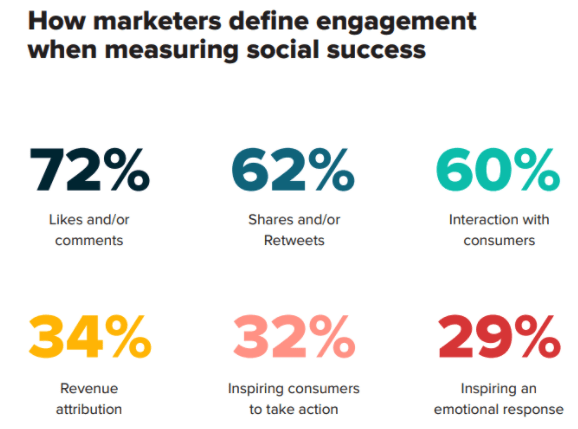Tag: Social media strategy
The Role of Social Media Policies – Reflection on INF506 Module 5

OLJ Task 12: Social media strategy / Policy development
There are indisputable benefits of social media (bringing communities and organisations closer together, creating more opportunities for engagement). Having previously discussed how it is no longer a question of if we should embrace social media, but how, when deciding to take the plunge into social media as an organisation, research from Di Gangi, Johnston, Worrell & Thompson (2018) points out that we must consider hiring practices and internal and external risks from all stakeholders perspectives – mitigating any possible negative circumstances.
In particular, Di Gangi, et al. (2018) recommend organisations consider writing social media policies to prepare for ALL internal and external legal, social and technical risks, such as:
- Legal: Classified/confidential/private information sharing; and Inappropriate/unethical/illegal content use; ;
- Social: Misrepresentation of the organisation’s views, values or mission by individuals which diminishes the organisation’s reputation both internally and/or externally; Misinformation or errors in content by users or staff (including ‘fake news‘ aka propaganda, deception, manipulation, fabrication, news satire and news parody used to spread mis-information with potential to cause social, corporate and political unrest and instability (Rampersad & Althiyabi, 2020)); [This makes me think of how, when books first started being published, humans believed them to be the absolute truth – simply because of the belief that if it were written down than it must be true. Similarly, the evolution of news radio and then televisions had similar effects, humans believed everything they saw on television as true (and in some cases, advertising to
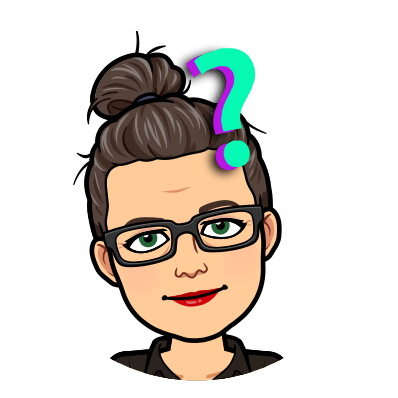 children has had considerable back lash and regulation because their brains are not fully developed enough to determine fact from fiction). Is the evolution of fake news and the need to determine the validity of information on social media – eg. the determination between fake news and real news, any different then than the ability say, to determine war propaganda as false? Just because the means – social media vs newspapers for example – has changed, should the consequences for negative behaviours not be the same?… Food for thought.]
children has had considerable back lash and regulation because their brains are not fully developed enough to determine fact from fiction). Is the evolution of fake news and the need to determine the validity of information on social media – eg. the determination between fake news and real news, any different then than the ability say, to determine war propaganda as false? Just because the means – social media vs newspapers for example – has changed, should the consequences for negative behaviours not be the same?… Food for thought.] - Detrimental distortions of market perceptions by providing a coordinating platform or disproportionate voice/visibility to minority opinions with questionable basis in fact; Misperception that the organisation is not adept at social media platforms or that what is offered is less than what is available face-to-face; Accidental or unauthorised third party searches or sharing of information or resources over an unlimited period of time (possibly for economic gain or with intent to cause harm) that is beyond the organisation’s control; Reduced staff efficiency or increased distraction;
- Technical: Third party unauthorised use of the platform account(s) to cause harm; Increased server/band-with/technology resource requirements; Temporary outages or updates required; Malware (malicious software)/false profiles/false posts/false content uploads that cause damage to the organisation, staff or resources.
LOVE THIS VIDEO! I’ve shared it with everyone I know on Facebook:
Communication Plan
Bunker (2017) discusses the purposes of choosing a social media platform and directs us to the American Library Association (ALA) for their recommendations on creating a communication plan. Bunker (2017) also recommends that organisations prepare for a successful leap into social media platforms by frequently reviewing, surveying and knowing our context and patrons’ information needs, knowing what communication methods they prefer, aiming to match and connect the face-to-face attitude and environment with the online environment and to not be afraid to take some risks – trialling several platforms to find what works best. Bunker (2017) also suggests we clearly determine our goals for pursuing social media platforms (eg. increased awareness of our values, connections and partnerships with community, increased traffic and outreach in our library and online, strengthened loyalty and trust, real-time news and update delivery, awareness of our resources and programs, modelling digital citizenship, teaching and demonstrating information literacy or research skills, and building links to other media networks.
Moreover, the research by Humphries (2019), supported by King (2015), states that if we decide to partake in organisational social media, we must be prepared to not only plan strategically but also we must monitor engagement if we want to reach social media optimisation.
King (2015) even goes so far as to say that we must have a pre-emptive understanding of social media analytics to help set and reach goals for growth, engagement, interactions, visits, or even larger goals like building connections or partnerships, improving information literacy, or other strategic plan goals. And I just realised that I’ve been running a Facebook (FB) teachers group (Teachers Who Know Me) with about 160 members for 5 years and I did not know about the ‘Insight’ section as the group admin. I immediately had a look and my analytics are pretty woeful, (basically, no interaction from my teacher friends who all seem to use FB socially rather than professionally) but the graphs and information available are pretty amazing. (They’ve also just updated the tagging system to include hashtags so that is helpful and I can find something I’ve posted much easier now).
 In looking at the different analytics discussed in King (2015) I am curious about how fast these platforms are changing. Google+ was replaced with GoogleCurrents (neither faring very well) and Flickr is just not on my radar for images as I prefer to get them from Creative Commons (CC). Which leads me to the question, do CC provide analytics for those uploading images? I looked at their site and they do collect ‘Cookies’ for CC use but what about those who are uploading? Perhaps it is something they might consider?
In looking at the different analytics discussed in King (2015) I am curious about how fast these platforms are changing. Google+ was replaced with GoogleCurrents (neither faring very well) and Flickr is just not on my radar for images as I prefer to get them from Creative Commons (CC). Which leads me to the question, do CC provide analytics for those uploading images? I looked at their site and they do collect ‘Cookies’ for CC use but what about those who are uploading? Perhaps it is something they might consider?
Content creation
Bunker (2017), supported by Peacemaker, Robinson & Hurst (2016), and Xu & Saxton (2018) recommend we attempt to improve the social media algorithms and increase our target audience’s ‘social capital‘ by linking our content to popular topics, utilising # (hashtags), hyperlinks, images, videos, global and local network links (a variety of diverse ‘community ques’), gradually increasing our viewer rates over time.
Bunker (2017) also provides a framework for creation of content that links to the organisation’s mission, vision, values or strategic plan – recommending a few strategies, but having read her lists, I’ve created my own template for this social media (strategy) plan which I will include in my final assessment.
It also occurs to me that an organisation would need to have a central location for all of the social media account information, given the constant flux of staff in most education settings. Thus, I’ve created another page on my GoogleSheet (also to be included in the final assessment).
Trouble shooting: See NSW Department of Education. (2018). Social media implementation procedures.
References
Bunker, L. (2017). Picking a platform and finding a voice. In S. W. H. Young & D. Rossmann (Eds.), Using Social Media to Build Library Communities : A LITA Guide. Blue Ridge Summit, UNITED STATES: Rowman & Littlefield Publishers.
Di Gangi, P. M., Johnston, A. C., Worrell, J. L., & Thompson, S. C. (2018). What could possibly go wrong? A multi-panel Delphi study of organizational social media risk. Information Systems Frontiers, 20(5), 1097-1116. doi: 10.1007/s10796-016-9714-2
Humphreys, S. (2019). Tweeting into the void?: Creating a UK library twitter list and analyzing best practice – successes and myths. Insights, 32, 1-23.
Peacemaker, B., Robinson, S., & Hurst, E. J. (2016). Connecting best practices in public relations to social media strategies for academic libraries. College & Undergraduate Libraries, 23(1), 101-108. doi: 10.1080/10691316.2016.1134244
Rampersad, G., & Althiyabi, T. (2020). Fake news: Acceptance by demographics and culture on social media. Journal of Information Technology & Politics, 17(1), 1-11. https://doi.org/10.1080/19331681.2019.1686676
Xu, W., & Saxton, G. D. (2018). Does stakeholder engagement pay off on social media? A social capital perspective. Nonprofit and Voluntary Sector Quarterly, 48(1), 28-49. doi:10.1177/0899764018791267
Information and society – Reflection on INF506 Module 2
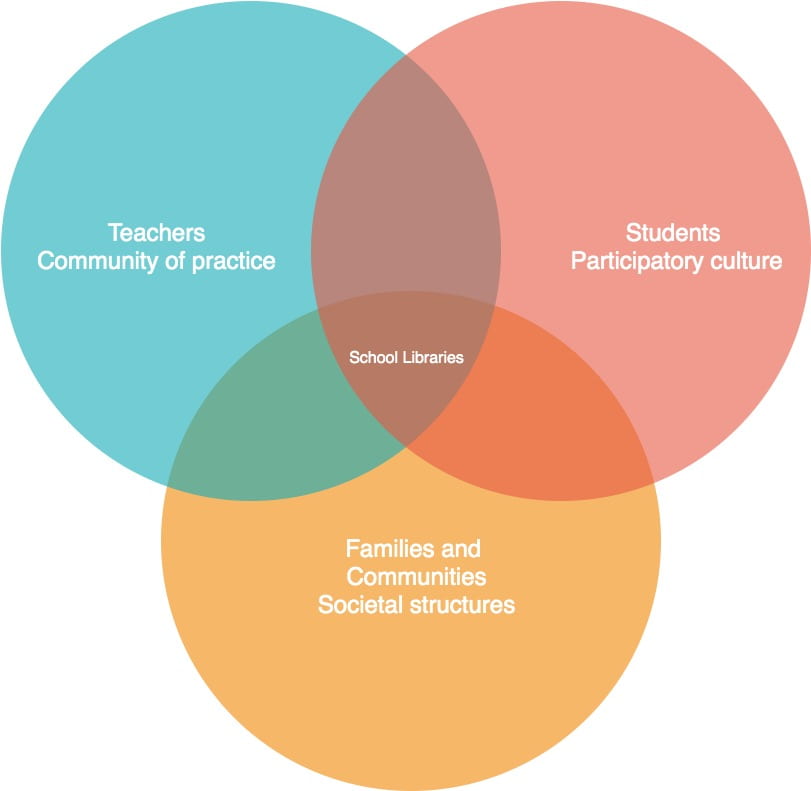
OLJ Task 2: The influence of technology on society or OLJ Task 3: Reflections on the impact of change
To be or not to be (active on social media) is no longer the question
 If we want ‘customer-driven, socially rich, and collaborative model of service and content delivery’ (module 2) then we must stop asking ‘why’ or ‘when’ and start asking ‘how.’
If we want ‘customer-driven, socially rich, and collaborative model of service and content delivery’ (module 2) then we must stop asking ‘why’ or ‘when’ and start asking ‘how.’
Why do we expect teachers to have a work culture aiming for a ‘community of practice’ (which I’ve discussed at length in previous blog posts, but also mentioned by Nisar, Prabhakar, G & Strakova, 2019), however, conversely, we expect students work almost entirely independently? Today’s working society has shifted, and so too has kid culture. Just as work places are becoming communities of practice, 21st century students have a participatory culture (also discussed in previous blog posts).
Jenkins, Clinton, Purushotma, Robison & Weigel (2006, p.3) define a participatory culture as: “a culture with relatively low barriers to artistic expression and civic engagement, strong support for creating and sharing one’s creations, and some type of informal mentorship whereby what is known by the most experienced is passed along to novice. A participatory culture is also one in which members believe their contributions matter and feel some degree of social connection with one another (at least they care what other people thing about what they have created).”
According to Jenkins (et al., 2006), forms of participatory culture could include affiliations, expressions, collaborative problem-solving and circulations [“Affiliations – memberships, formal and informal, in online communities centred around various forms of media, such as Friendster, Facebook, message boards, meta-gaming , came clans or MySpace); Expressions – producing new creative forms, such as digital sampling, skinning and modding, fan video-making, fan fiction writing, zines, mash-ups); Collaborative Problem-solving – working together in teams, formal and informal, to complete tasks and develop new knowledge (such as through Wikipedia, alternative reality gamine, spoiling); or Circulations – shaping the flow of media (such as podcasting, blogging).”]
Artega (2012, p.72) writes, “social media extends the social milieu to the digital sphere where opportunities for global social participatory learning are plentiful.” Thus, to be viable in today’s globally connected society, particularly in western civilisation where a participatory culture has become the ‘norm,’ an educational facility’s social media presence is not only something that is necessary, but is something that must be done effectively.
“For library managers, questions are moving beyond how to initiate and launch social media to the more challenging problem of how to do social media well— how to better integrate social media into the life of the library, how to more fully engage the library’s staff and users in social media; how to make the library’s social media more effective in outreach and delivery of services, and how to measure the library’s presence and activities within social media in ways that truly matter. The next wave of trends in social media use are also always looming on the horizon— what will be the next big social site where users will be going next within the social media landscape, and should the library follow?” (Mon, 2014, p.51).
Some purposes for social media have been suggested by Mon (2014, p.24) as supported by the research of AlAwadhi (2019) to include: increased avenues for feedback from users, promotion and advocacy of the school &/or library, improved information access through outreach programs, deliverable educational or support hubs, improved collections and stronger or more frequent global collaborations. Notably, Kwon’s (2020) research places building trust ahead of information motivation as a reason for use of community social media platforms.
Roadblocks to consider
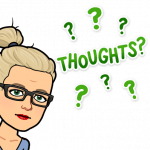 While reading Adner & Kapoor (2016) it occurred to me that, like all change processes, there will be roadblocks. This includes access to technology (either because of infrastructure, financial or intellectual constraints), as well as resistance to change from staff or families who are either change fatigued or stuck in the web1.0 mentalities. Perhaps there are issues around work-life balance, either for adults (addicted to screens and social media or overwhelmed by the need to take work home or have work cross over into the social sphere) or children (similarly addicted to screen time). These will all need to be considered in the 4 phases of creating a group digital presence or organisation’s digital learning environment (discussed at length in previous blog posts).
While reading Adner & Kapoor (2016) it occurred to me that, like all change processes, there will be roadblocks. This includes access to technology (either because of infrastructure, financial or intellectual constraints), as well as resistance to change from staff or families who are either change fatigued or stuck in the web1.0 mentalities. Perhaps there are issues around work-life balance, either for adults (addicted to screens and social media or overwhelmed by the need to take work home or have work cross over into the social sphere) or children (similarly addicted to screen time). These will all need to be considered in the 4 phases of creating a group digital presence or organisation’s digital learning environment (discussed at length in previous blog posts).
There is also the issue of needing to be innovative in the types of platforms that we promote as educators (as supported by the research of Manca (2020). Which brings up another roadblock to implementing social media for schools is the fact that there is an age limit for access – most students in K-6 Australian educational settings are below the age of 13 and cannot be encouraged by educators to look at nor participate in most social media applications. This means we have to tailor our content to an older demographic and seek out other (less public) social media platforms for younger students.
Some additional roadblocks or things to consider have been provided by Business.gov.au (2019) and they are to have a clear social media strategy, be mindful that additional staff or resources may be required for daily monitoring of all online platforms, be prepared for inappropriate behaviour (bullying, harassment, negative feedback, misleading or false claims, copyright infringement, information leaks or hacking) and have an action plan ready within your policy documents detailing specifically how to deal with these instances prior to launch date(s).
Hicks, Cavanagh & VanScoy (2020) recommend monitoring a library’s online presence via a ‘social network analysis (SNA).’ The SNA is a ‘theoretical framework and quantitatively oriented methodology’ for libraries to understand their ‘big data stories’ or connections with their community identifying relevant patterns and relationships among individuals, groups, or organisations over a specified period of time.
All of these issues need to be incorporated into the digital learning environment creation plan, a four phase process that I’ve detailed in a previous blog post from Digital Citizenship, but that can best be summarised in this infographic:
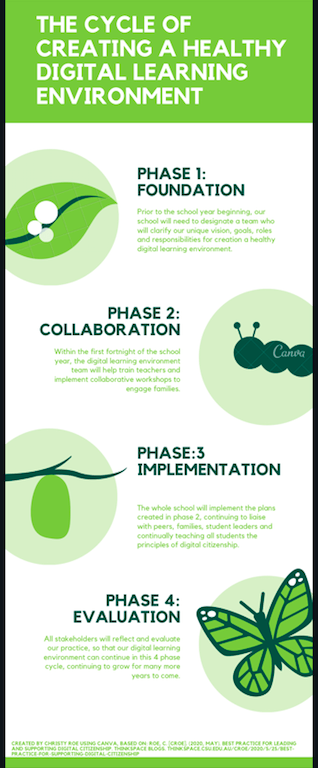
How to design a platform and design it well, improving engagement (web 2.0)
This leads to the next issue – how to have a website (web 1.0), that is interactive (web 2.0) and makes the step towards linking the online world to the offline world (web 3.0). We need to be thinking beyond web 1.0 in terms of having a simple ‘face’ website that offers little to no interaction and does not enable, encourage (nor monitor) engagement but a platform, website and social media presence that actively engages our users. The web 2.0 model of ‘likes’ is also becoming an outdated model and with web 3.0 we must begin to think of our digital presence as fully interactive, including building meaningful ongoing connections (Barnhart, 2020).
But each context must first ask “what does it mean to have ‘engaged users?” and “what platforms / website / social media should we use to engage them?”
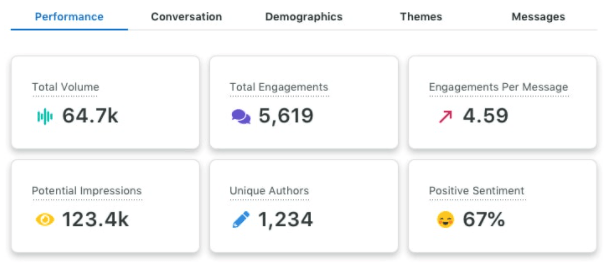
After my practical work-placement in a local public library, where I completed two weeks of ‘virtual’ research on website design (offering several recommendations for website development for the library), I realise that there are almost infinite resources, research and opinions on how to design effective websites. I don’t believe that my understanding of moving from the web presence currently (as web 1.0) to web 2.0 (more interactivity) to even web 3.0 (content creation by the users) was fully developed, until I watched the video provided in module 2 of INF506 (Schwerdtfeger, 2013). I wish I had been able to communicate this idea previously.
Yet, one key article that I did find, in the interest of brevity, was Garett, Chiu, Zhang & Young’s (2016, p.1) literature review on website design in terms of user engagement. Their 4 notable findings were:
- “Websites have become the most important connection to the public and using social media links on websites may increase user engagement;
- Proper website design is critical for user engagement, because poorly designed websites result in a higher user ‘bounce’ rate (users do not proceed past the home page) whereas, well designed websites encourage user exploration and revisit rates;
- The International Standardised Organisation (ISO) (in Garett, et al., 2016, p.1) defines website ‘usability’ as: “the extent to which users can achieve desired tasks (e.g., access desired information or place a purchase) with effectiveness (completeness and accuracy of the task), efficiency (time spent on the task), and satisfaction (user experience) within a system”;
- Out of the 20 identified design elements that impact user engagement, 7 key design elements (in order of importance) are navigation, graphical representation, organisation, content utility, purpose, simplicity and readability.” Garett et al. expand these design element definitions, but the key words are:
-
- Effective navigation: consistent menu/navigation bars, search features, multiple pathways and limited clicks/backtracking.
- Engaging graphical presentation: images, size and resolution, multimedia, font, font colour and size, logos, visual layout, colour schemes, and effective use of white space.
- Optimal organisation: logical, understandable, and hierarchical / architectural structure, arrangement / categorisation, and meaningful labels/headings/titles/keywords.
- Content utility: information is sufficient, of ongoing quality and relevant
- Clear purpose: 1) establishes a unique and visible brand/identity, 2) addresses visitors’ intended purpose and expectations for visiting the site, and 3) provides information about the organisation and/or services.
- Simplicity: clear subject headings, transparency, optimised size, uncluttered, consistent, easy, minimally redundant and understandable.
- Readability: easy, well-written, grammatically correct, understandable, brief, and appropriate.
References
Adner, R., & Kapoor, R. (2016). Right tech, wrong time. Harvard Business Review, 94(11), 60-67.
AlAwadhi, S. (2019). Marketing academic library information services using social media. Library Management, 40(3/4), 228-239. doi:10.1108/LM-12-2017-0132
Arteaga, S. (2012). Self-Directed and transforming outlier classroom teachers as global connectors in experiential learning. (Ph.D.), Walden University. http://search.proquest.com.ezproxy.csu.edu.au/docview/1267825419/BD063751849440E5PQ/1?accountid=10344
Barnhart, B. (2020, January 5). The most important social media trends to know for 2020. [Blog post]. https://sproutsocial.com/insights/social-media-trends/
Business.gov.au (2019). Social media for business. https://www.business.gov.au/Marketing/Online-presence/Social-media-for-business
Garett, R., Chiu, J., Zhang, L., & Young, S. D. (2016). A literature review: website design and user engagement. Online journal of communication and media technologies, 6(3), 1.
Hicks, D., Cavanagh, M. F., & VanScoy, A. (2020). Social network analysis: A methodological approach for understanding public libraries and their communities. Library & Information Science Research, 42(3), 101029. doi: https://doi.org/https://doi.org/10.1016/j.lisr.2020.101029
Jenkins, H., Clinton, K., Purushotma, R., Robison, A. J., & Weigel, M. (2006). Confronting the challenges of participatory culture. https://www.macfound.org/media/article_pdfs/JENKINS_WHITE_PAPER.PDF
Kwon, K. H., Shao, C., & Nah, S. (2020). Localized social media and civic life: Motivations, trust, and civic participation in local community contexts. Journal of Information Technology & Politics, 1-15.
Manca, S. (2020). Snapping, pinning, liking or texting: Investigating social media in higher education beyond Facebook. The Internet and Higher Education, 44, 100707. doi: https://doi.org/https://doi.org/10.1016/j.iheduc.2019.100707
Mon, L. (2014). Social Media and Library Services. Morgan & Claypool Publishers. ProQuest Ebook Central, http://ebookcentral.proquest.com/lib/csuau/detail.action?docID=2010483.
Nisar, T. M., Prabhakar, G., & Strakova, L. (2019). Social media information benefits, knowledge management and smart organizations. Journal of Business Research, 94, 264-272. doi: https://doi.org/10.1016/j.jbusres.2018.05.005
Schwerdtfeger, P. [Patrick Schwerdtfeger] (2013). What is web 2.0? What is social media? What comes next? https://www.youtube.com/watch?v=iStkxcK6_vY
Van Dijck, J. (2018). Introduction. In J. Van Dijck (Ed.), The Platform Society. Retrieved from Oxford Scolarship Online.
